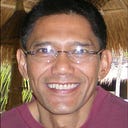
As if I needed another hobby (I have MANY), I just got hooked on Fungi; specifically, the whole mycelium world in general.
Those who know me, I took up gardening and botany around June this year. After many failed attempts at growing plants for the first time, I have had enough success (so far) that now I am happy letting it go on auto-pilot.
My tomato, kankong, snow peas and peppers are growing healthy and stronger everyday. My trick? I quit “over-loving” them with too much water, too much fertilizer and most importantly, I quit getting so depressed when a few out of a group of seedlings didn’t germinate or whenever a young plant died.
But this post is about my new hobby: Fungi.
How did this happen?
Simple.
After listening to a lecture on Mycelium by Paul Stamets, I was absolutely hooked!
About Paul Stamets -

Stamets is on the editorial board of the International Journal of Medicinal Mushrooms (Begell House).
He is an advisor to the Program for Integrative Medicine at the University of Arizona College of Medicine.
Although he is not a medical practitioner, he recommended contacting Dr. Andrew Weil during a Coast to Coast AM interview with George Noory which was broadcast on September 13, 2018.
He is involved in two National Institutes of Health-funded clinical studies on cancer and HIV treatments using mushrooms as adjunct therapies.
He earned nine patents on the antiviral, pesticidal, and remedial properties of mushroom mycelia. A strong advocate of preserving biodiversity, Stamets supports research into the role of mushrooms for ecological restoration.
Stamets is an advocate of the permaculture system of growing, and considers fungiculture a valuable but underutilized aspect of permaculture. He is interested in the use of mushrooms in bioremediation, a process he terms mycoremediation.
See this great video: “6 ways mushrooms can save the world”
So Many Neat things I’ve Learned so far…

Luckily, my past medical skills made it easy to make agar medium, petri dish mycelium, and inoculate other substrate and even liquid cultures.
I’ve been successful with using coffee grounds, cardboard, dried grass with dried oatmeal, coconut palm fronds, and rice as viable mycelium substrates.
I did have two instances of trichoderma, but that is because I am winging it without a glove box and without a laminar flow hood.
Basically, I just use A LOT of hydrogen peroxide and alcohol.
Then I hold my breath and use the cleanest technique when inoculating occurs! By no means is it anywhere near aseptic technique!
If all goes well, my first four fully colonized “blocks” will be ready to fruit into Reishi, Wild, Oyster, and button mushrooms.
The only thing I haven’t figured out yet is how to control the temperature, humidity, and lighting for each species.
My next target mushrooms are the more finicky and harder to cultivate Morel and Shitake.
In conclusion, I am having fun with this new hobby because of the significance of mycelium in our ecology and contributions to life on Earth since humans broke away from fungi long ago.
By JaiChai
“Really Appreciate You Stopping By. Truly hope to see you again!”
About the Author

Believing that school was too boring, he dropped out of High School early; only to earn an AA, BS and MBA in less than 4 years much later in life — while working full-time as a Navy/Marine Corps Medic.

In spite of a fear of heights and deep water, he performed high altitude, free-fall parachute jumps and hazardous diving ops in deep, open ocean water.
After 24 years of active duty, he retired in Asia.
Since then, he’s been a full-time, single papa and actively pursuing his varied passions (Writing, Disruptive Technology, Computer Science and Cryptocurrency — plus more hobbies too boring or bizarre for most folk).

He lives on an island paradise with his teenage daughter, longtime girlfriend and three dogs.
Originally published at https://www.uptrennd.com.
